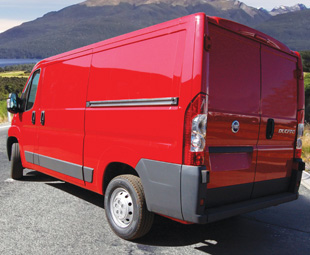Sustaining growth

The broad based nature of the market strength was noteworthy, and the revival of bus sales activity has surprised those observers who had anticipated an extended period of stagnation after Soccer World Cup requirements had been fulfilled in 2010. But, says FRANK BEETON, market growth that has been evident during the first quarter, and which is likely to continue for one or two months more, cannot be sustained for the whole of the year due to the crisis in Japan.
The review period for this commentary is the first quarter of 2011, January to March 2011 inclusive.
These reviews are presented on a quarterly timescale to reduce the impact of short-term market distortions which are often created by specific bulk-buy deliveries, the launch of new products, and/or the run-out of obsolete product ranges.
TRUCK MARKET RESULTS
The first quarter of 2011 has produced progressively increasing total monthly volumes of commercial vehicle sales, with the result that the year-on-year comparison with the equivalent initial three months of 2010 has revealed a volume increase of 24%. This improvement is supported by substantial contributions from all three freight vehicle categories contained within the market. The result for March 2011 provided the market with its best individual monthly volume since October 2008.
When comparing the first quarter 2011 performance with the immediately preceding final three-month period of 2010, the total market improved by a margin of 9,6%, confirming the strengthening trend that has been evident since the completion of the Soccer World Cup (SWC) tournament in mid-2010. This was driven by a volume improvement of 19,5% in respect of entry level MCVs, and 13,7% growth in premium payload EHCV volumes. In a remarkable coincidence, mid-range HCV sales were identical to the last unit during both of these two adjacent quarters, while bus deliveries fell back by a margin of 38,5%.
The supply industry was able to look back with considerable satisfaction on the quarter just completed, when the steady restoration of consistent volume growth persisted. Comments from the industry suggest that most of the momentum was generated by replacement, rather than fleet expansion purchases. The individual March result was particularly significant in that it was devoid of the disruptive strike action and reduced number of working days in the months that had preceded it, and thus provided the players in the market with a good indication of the type of result that can be achieved under normal business conditions. The broad based nature of the market strength was also noteworthy, and the revival of bus sales activity has surprised those observers who had anticipated an extended period of stagnation after Soccer World Cup requirements had been fulfilled in 2010.
SEGMENTATION DYNAMICS
The most significant recent feature of the segmentation breakdown of this market has been the recovery of EHCV market share over the past 12 months. After being severely handicapped by restrictions on the availability of acquisition finance during 2009, this segment has regained and consolidated a clear market leadership position, exceeding 40% penetration for the three most recent quarters, and achieving 42,2% over the most recen t three month period. This spectacular revival in EH sales activity suggests that fixed investment is alive and well in South Africa, and that credit has become more readily available to buy the higher priced units in the market. During March 2011, this segment recorded its first 1 000 unit-plus month sales result since October 2008. Although now relegated to a runners-up position, the entry-level MC segment has also recovered substantially from its relatively subdued activity level in 2010, and currently occupies second position at 36,5% market share. The heavier 4×2 distribution type vehicles in the HCV segment, however, have fallen substantially below the 20% market penetration level that they occupied tenaciously for the past five years, and are currently positioned at 17,6%, possibly indicating some level of fleet saturation post-SWC. Bus sales, at 3,7% penetration, have fallen significantly below the elevated levels that they occupied during 2009 and 2010, but have returned to similar market penetration ratios to those maintained throughout the 2005-2008 timescale, well before any significant SWC impact could be discerned.
t three month period. This spectacular revival in EH sales activity suggests that fixed investment is alive and well in South Africa, and that credit has become more readily available to buy the higher priced units in the market. During March 2011, this segment recorded its first 1 000 unit-plus month sales result since October 2008. Although now relegated to a runners-up position, the entry-level MC segment has also recovered substantially from its relatively subdued activity level in 2010, and currently occupies second position at 36,5% market share. The heavier 4×2 distribution type vehicles in the HCV segment, however, have fallen substantially below the 20% market penetration level that they occupied tenaciously for the past five years, and are currently positioned at 17,6%, possibly indicating some level of fleet saturation post-SWC. Bus sales, at 3,7% penetration, have fallen significantly below the elevated levels that they occupied during 2009 and 2010, but have returned to similar market penetration ratios to those maintained throughout the 2005-2008 timescale, well before any significant SWC impact could be discerned.
MANUFACTURER PERFORMANCE
Chart 1 illustrates the relative market performance and ranking of each participating manufacturer in the quarter just completed, as compared to the returns for the immediately equivalent preceding period.
Readers should note the groupings of manufacturers contained in this section of the report. The rule employed is that if a manufacturer/group sells more than one brand through its distribution channels, then all sales for those brands will be consolidated in the result for the manufacturer/group. Thus, Mercedes-Benz includes Freightliner and Fuso, Toyota/Hino contains both brands, MAN includes Volkswagen (Constellation) trucks and Volksbus passenger units, but not VW commercial vans (listed separately), and Volvo Trucks includes Mack and Renault.
Mercedes-Benz SA
The long-term market leader improved its market share performance during the quarter just completed by a margin of slightly more than 2%, to reach a penetration level of 27,3%. Overall leadership of the MCV and EHCV segments was also achieved during this period. All three brands in the Group improved their market share in the first quarter, with Mercedes-Benz holding 17,9% penetration, Fuso at 4,8% and Freightliner 4,6%. Promotional emphasis during the review period has included extensive advertising of the Fuso range, which has also added new “niche” models, and revisions to the Mercedes-Benz Axor and Atego model lineups.
Hino/Toyota
Maintaining its traditional runners-up berth in the local market, Toyota SA’s truck operation, at 14,4% penetration, gave up slightly more than 0,6 percentage points in market share compared to its performance during the final quarter of 2010, but resumed leadership of the important cruiserweight HCV segment, which, as usual, was dominated by Japanese brands. Hino’s major promotional event during the first quarter was the introduction of additional models in the EHCV 700 Series range, featuring higher power output options and ZF automated mechanical transmissions.
UD Trucks SA
With the corporate name change from Nissan Diesel completed in 2010, third placed UD Trucks improved its market share performance during the first quarter of 2011 by half a percentage point, recording just less than 12% penetration. Once again, this brand has dominated all Japanese sourced products in the EHCV segment, and continued to recover its position in the MCV segment, where the recently revised product lineup improved its volume performance by a margin of 86% over the absolute number of equivalent units reported during the last quarter of 2010. UD also claims to have been the top South African exporter of trucks during 2010.
Tata
Indian manufacturer Tata returned a considerably improved quarter-on-quarter result during the first three months of 2011, increasing its market share by 1,5 percentage points from its final quarter 2010 position, to reach 5,5% overall penetration. This resulted from volume growth of nearly 52% over the previous quarter, and elevated the brand by two market ranking positions to seventh place. The performance improvement was spread over all three goods vehicle segments, with the greatest volume gain (55%) being recorded in the MCV category. Tata has commenced low-level local promotion of its Prima “World Truck” range, which is expected to enter the local market during 2011.
MAN Group
Consistently maintaining fifth position in the local market standings, the MAN Group nevertheless gave up 0,9% of market share in the comparison between the two most recent quarters, ending at 8,3% penetration in the first quarter of 2011. The dissipation of SWC demand for luxury coaches has resulted in MAN regaining its traditional leadership of the local Bus segment, although current indications suggest that the manufacturer may have to shift away from its heavy concentration on front-engined buses to maintain this position in the medium term. MAN marked the delivery of its 500th bus to Cape Town operator Golden Arrow during the review period. The Volkwagen component of the Group showed welcome improvement during the first quarter, gaining 0,5 percentage points of market share, and this reflects some detailed specification improvements that have recently been introduced. It is expected that this process will continue and may extend to the future substitution of MAN engines for the MWM and Cummins diesels currently used in VW badged products.
GMSA (Isuzu)
Fourth-placed Isuzu Trucks South Africa gave up 0,7 percentage points of market share in comparison with  its performance during the last quarter of 2010, at the end of a year which had seen considerable marketing exposure for the brand’s comprehensively renewed product lineup. There was, however, an encouraging 56% improvement in absolute EHCV sales volumes, reflecting good early market acceptance of the intermediate FX series.
its performance during the last quarter of 2010, at the end of a year which had seen considerable marketing exposure for the brand’s comprehensively renewed product lineup. There was, however, an encouraging 56% improvement in absolute EHCV sales volumes, reflecting good early market acceptance of the intermediate FX series.
Volvo Trucks
Volvo Trucks continues to improve its position in the South African market, rising one notch to end in sixth position at the end of the review period, and gaining 1,5 percentage points in share to reach slightly more than 7% penetration. This is only marginally behind the best recent result registered during the third quarter of 2010, and suggests a return to penetration levels last achieved consistently during 2004. One feature of Volvo’s recent performance has been the increasing contribution of Renault sales, now returning to volumes only seen previously during the Imperial Group’s patronage of the brand. There has been a substantial elevation in the recent visibility of Renault through application-specific promotional events, and the impression has been gained that Volvo is serious about establishing a lasting presence for the brand in the local market, following a long series of ill-fated attempts by previous custodians.
Scania
Swedish manufacturer Scania slipped two positions in market ranking to occupy eighth place during the first quarter, giving up 0,9% in market share in the process, and ending at 5% penetration during the review period. Much of the lost ground can be ascribed to lower than usual bus sales volumes, which have fluctuated considerably over the past 12 months. The recently introduced P230 DB distribution truck, giving Scania access to the HCV market segment, did not record any sales during the first quarter of 2011.
Iveco
For reasons not yet disclosed, Iveco did not report any sales to NAAMSA during the months of February and March 2011. The market position and share reflected here for the first quarter, therefore, consists only of January deliveries, and is totally unrepresentative. This situation makes comment and analysis of the result inappropriate, so this will be withheld until normal reporting resumes, or some explanation is forthcoming.
Navistar International
This American brand, now part of the NC² global Navistar/Caterpillar partnership, held steady in volume terms during the first quarter, but, in spite of giving up a small margin of market share, experienced a one position improvement in market ranking to occupy tenth place. Sales activity, at time of writing, remains firmly concentrated in the EHCV premium truck segment, and it is anticipated that a new Global Eagle model will be exhibited at the Johannesburg International Motor Show in September.
Powerstar
Chinese manufacturer Powerstar improved its first quarter market penetration performance by 0,25 percentage points, ending with 0,8% share, but fell one position in ranking to occupy 13th position. With offshore investment into the local operation now confirmed, expansion in market coverage beyond the construction sector seems increasingly likely, and parent company Bei Ben’s newly-launched V3 series presents as a possible candidate for local introduction.
Babcock/DAF
Now into its second quarter of sales reporting, Babcock/DAF improved its market ranking by one position to occupy 15th place during the first quarter, and captured 0,2% of the total market volume. Promotional efforts, thus far, have concentrated on building credibility for the new distribution partnership, and dealerships are expected to open in Cape Town and Durban later this year.
VDL
This Dutch Bus specialist supplier, utilising power units sourced from DAF, continues to operate in South Africa at low volume levels, and the nine units that it delivered during the first quarter of 2011 were enough to secure 16th market position, one lower than its fourth quarter 2010 ranking.
Van Manufacturers
Two vehicle manufacturers compete in the MCV segment of this market only with European-sourced integral van-derived products. Of these, Peugeot (12th position, 0,9% penetration) recorded an improved market share in the first quarter of 2011, while, Fiat (14th position, 0,3% market share) lost ground. Nissan has failed to report any volumes for its formerly successful Interstar product for the past two quarters. It now appears that both Nissan and Opel have exited the market with their joint venture vans, and it remains to be seen if this situation is altered by the arrival of new generation product from Europe.
Non-Reporting Manufacturers
Readers should note that local sales volumes of several commercial vehicle brands, including FAW, Warrior (Dong Feng), Foton and Ashok Leyland, are not yet reported to Naamsa, and are, therefore, excluded from the comments and data contained in this report. It should also be noted that Associated Motor Holdings has recorded some sales in the MCV segment during the review period. In line with the policy of that group, no details of the individual models sold have been disclosed to Naamsa, but from observation we can deduct that these vehicles are from the Hyundai HD Series of light trucks. These volumes are not subject to the full Naamsa verification process, and consequently have not been included in the Chart 1 database. Memo: If the volumes were to be included in an expanded market, AMH’s overall market share would be less than 1%, and its MCV segment share would be 2,6%.
GENERAL MARKET COMMENTS
The domestic financial environment remains stable, with the rand steady, and interest rates expected to remain near their present levels for much of the year. These factors should encourage transporters to pursue fleet replacement and expansion plans in line with their business priorities, in order to optimise the profitability of their operations. However, South Africa is exposed to global influences, and the impact of important offshore issues cannot be ignored. Firstly, the continuing unrest in the Middle East is maintaining speculator interest in oil prices, and the current trend is still upwards, with sudden short-term volatility. The result has been regular steep rises in the local price of fuel, with resulting negative implications for operator profitability.
The other external factor is the Tōhoku earthquake and tsunami that struck Japan early in March, causing widespread death, damage and disruption. Up to now, local distributors of Japanese sourced vehicles, who accounted for 42% of all South Africa’s trucks, buses and vans purchased during 2010, are still struggling to establish the full impact of these events. Some disruption of supply will be inevitable, however, and this could extend beyond recognisable Japanese brands to some foreign makes sourcing unique critical components from that country. The capacity of manufacturers in alternative source countries to fill any shortfall in Japanese vehicle availability will be inhibited by South Africa’s unique legislative requirements of right-hand-drive and Euro 2 emissions standard. It is unlikely that any substantial numbers of vehicles built to this standard will be immediately available in overseas stockyards, and by the time that new stock can be built up, the Japanese operations should be well on the way to recovery.
At time of writing, it was impossible to gauge the full impact of this crisis, but it is becoming increasingly clear that local vehicle availability will come under intense pressure for at least two or three months around the middle of 2011. Responsible manufacturers are expected to make every effort to minimise disruption, and keep their customers informed, but it is now certain that South Africa’s commercial vehicle market will be supply-constrained, at least in terms of individual models, and possibly even popular brand ranges, during the balance of this year. Under these circumstances, the market growth that has been evident during the first quarter, and which is likely to continue for one or two months more, cannot be sustained for the whole of the year.
Published by
Focus on Transport
focusmagsa


